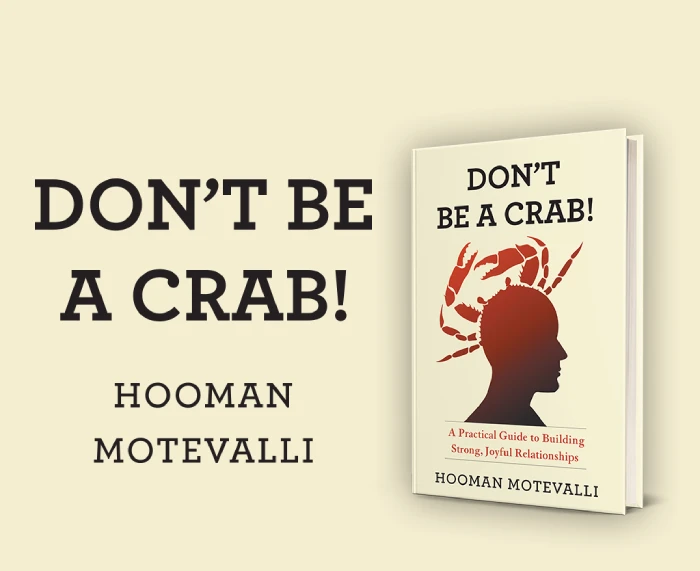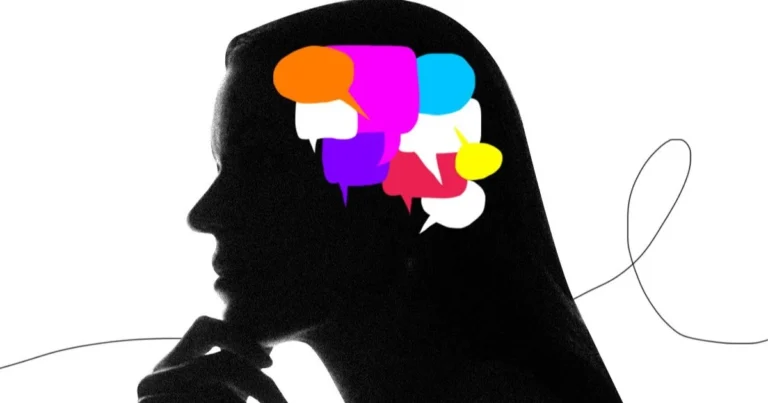Self-talk is not uncommon. It’s something we do all the time; for some, it’s the internal dialogue that guides them toward a particular course of action or decision. It’s a powerful voice that shapes how we perceive the world, make decisions, and interact with others. While it might seem harmless, our inner dialogue can profoundly affect our mental health, relationships, and ability to grow.
In Hooman Motevalli’s groundbreaking book “Don’t Be a Crab”, he explains how we all have such a companion not in our physical space but in our minds. In this blog post, we’ll be exploring powerful concepts in the book on how to become more aware of our inner dialogue the first step in transforming how we think, behave, and relate to the world around us.
But first.
What Is Self-Talk?
Self-talk is the inner voice that governs feelings, beliefs, and behaviors. A 2021 study revealed a strong correlation between our approach to solving problems and self-talk. This conversation is a permanent companion, or, as Hooman would say, “your roommate,” an appropriate term to stress its coexistence within us, whether it’s encouraging us throughout a hardship or pointing out a mistake.
Self-talk arises from the need for our brain to digest the enormous volume of information it gets every day roughly 11 million bits per second. It helps us in assessing circumstances, predicting results, and overcoming challenges. Unchecked, this voice, however, has the potential to misinterpret events, resulting in confusion and negative behaviors.
To understand how self-talk works, we’ll be describing a four-step process:
- The Observer
- The Analyzer
- The Distinguisher
- The Manager
How to Recognize Your Inner Dialogue (The Observer)
The first step in understanding self-talk is becoming aware and recognizing that your inner dialogue exists. A 2022 Havard Medical School study found that most people think about something other than what for 47% of their waking hours, frequently without realizing it.
Since many of us function on autopilot and aren’t conscious of the ongoing dialogues in our minds, this first-step awareness is crucial. Here is a straightforward three-rule checklist to help you become more conscious of the frequent discussions that take place in your mind, as well as who is engaged and what part they play in your life.
The Talk Check.
- Keep track of how often you talk to yourself.
- When you notice a conversation going on inside your head, try to stop it.
- When you can’t stop it, write it down word for word including the words you use to try to stop the conversation.
By doing this, you’ll begin to recognize the trends and triggers of your inner dialogue. According to 2021 research, people who consistently observe their self-talk exhibit better emotional control and decision-making skills. You’ll have taken the first step toward clarity and less uncertainty by recognizing these instances of self-talk.
How to Control Your Inner Dialogue (The Analyzer)
Consider Felix’s story from “Don’t Be a Crab”:
After a friend made remarks about his faith during a dinner conversation, this well-educated, typically kind man became engulfed in self-defeating thoughts. Felix’s inner dialogue led him to hold grudges instead of letting the situation go, which resulted in him gossiping about his friend and damaging several relationships. What began as a self-defense tactic turned into destructive behavior that went against Felix’s personal principles.
Unchecked self-talk creates patterns that can build us up or tear us down. A 2021 study revealed that negative self-talk can raise stress levels and have a big influence on one’s decision-making abilities. According to Hooman, “If we don’t observe and analyze this conversation, it will continue to negatively impact every area of our lives, day after day, year after year.”
Fortunately, the book offers practical tools to manage challenging moments when self-talk threatens to spiral:
- The Thumb in Fist exercise: Make a fist and tuck your thumb inside whenever you feel unsettled. This simple physical gesture serves as an anchor, reminding you to notice your ongoing internal dialogue.
- The Third Rule: Before starting any new action or reaction, pause for three seconds. This brief delay creates space to observe your self-talk and choose a more intentional response.
For additional quick strategies, learn how to shift negative self-talk in under 5 minutes to further control those challenging moments.
These techniques aren’t just coping mechanisms they’re gateways to deeper awareness that can transform how your inner dialogue influences your life.
How to Separate Your Inner Dialogue (The Distinguisher)
In our minds, what appears to be a straightforward monologue is actually a conversation between two different voices: “The Roommate” and our conscious self. Not every roommate is on our side. Although protection is its main objective, its tactics may backfire. It is based on preconceived notions, fears, and past experiences, which might result in negative counsel or exaggerated reactions.
A 2020 study revealed that there are different dialogues in our minds, and there’s a need to understand the similarities and differences between them. Being able to identify our inner voices enables us to resist the need to act on fear, rage, or old wounds and instead take the time to think things through and make deliberate decisions.
We must learn how to consciously listen to our inner dialogue and see which voice should be heeded and which should be ignored. Over time, this practice builds resilience, strengthens emotional intelligence, and helps us approach people and challenges with a calm, centered perspective.
How To Master Your Inner Dialogue (The Manager)
The next phase is to master the voices inside of you, turning your self-talk from a source of uncertainty or confusion into a powerful tool for development and clarity. Although we cannot stop our inner dialogue, we can control it and learn the number of times it makes us uncertain and unkind.
Forbes talks about how something as simple as self-talk can change your entire mindset, thus having a great impact on your journey in life. If left unchecked, your inner dialogue can create a storm of conflicting thoughts, making it hard to concentrate or make judgments.
However, with deliberate effort, this internal dialogue can turn into a positive force that provides inspiration, encouragement, and understanding. Hooman presents two strategies aimed at empowering us to take charge of this conversation and thrive on its potential.
- The Three-Seconds Rule: Pause for three seconds before reacting to any circumstance. You can assess whether your response is a result of The Roommate’s protective worries or of knowledge at this fleeting instant.
- Fixed short phrases: Create personal mantras to counter negative self-talk. For example, some practitioners use phrases like “Nothing ultimately belongs to me except the impossible graces and blessings I am receiving now” to maintain perspective during challenging moments.
You can turn your inner dialogue into a source of empowerment by applying these strategies to your everyday life. You take control of your ideas and steer them in the direction of positivity, purpose, and personal development rather than letting them rule you.
CONCLUSION
Your inner dialogue is more than just background noise it’s the architect of your reality. You can progressively change your self-talk from a source of limitation to a basis for development and connection by putting the strategies you’ve learned into practice.
Start small. Notice the conversations in your head without trying to change them. Pay attention to which voice is speaking your conscious self or The Roommate? As you develop this awareness, you’ll naturally begin to choose which voice to listen to, empowering yourself to create a more supportive and positive internal environment.
Keep in mind that this isn’t about achieving perfect self-talk. It’s about creating a healthier relationship with your inner dialogue, one that supports rather than hinders your growth. As Hooman emphasizes, this journey requires patience and practice, but the rewards stronger relationships, clearer thinking, and greater emotional resilience make every step worthwhile.







